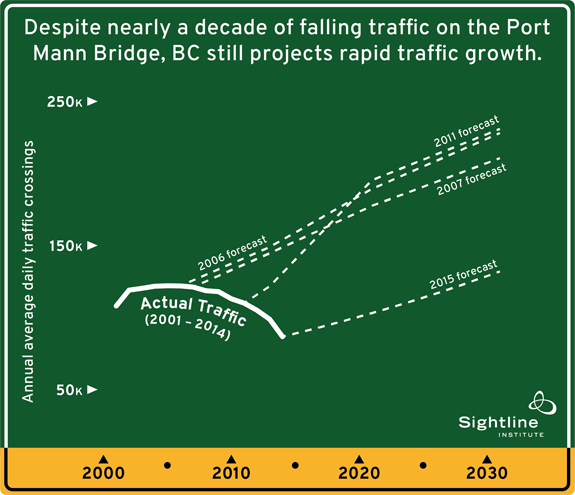The comedians in the Port Mann Bridge forecasting department are at it again: despite a 29 percent decline in traffic volumes on the Port Mann bridge between 2005 and 2014, the province is still predicting an immediate, sustained increase in traffic across the span:
That’s right—despite years and years of being wrong about the direction of future travel trends, they think they’ve finally spotted signs of a turnaround. You see, traffic volumes in December 2014 and January 2015 were a wee bit higher than they were in December 2013 and January 2014. And apparently that was enough for them to declare that..
“Traffic volumes on the Port Mann Bridge are stable and growing.”
and to make a forecast of…
“continual, long-term traffic growth on the Port Mann Bridge at a rate of about 2.5% per year.”
Of course, they could be right: just because they’ve been ridiculously, flat-out wrong about every single forecast they’ve made to date doesn’t mean that they haven’t spotted a new trend. Still, you’d think that years of making preposterous traffic forecasts would give them a little humility.
But maybe they can’t afford to be humble. At this point Port Mann has become a major sore point for provincial transportation policy. The bridge is hemorrhaging red ink, and because traffic hasn’t lived up to expectations, tolls simply aren’t enough to cover the cost of operations and debt payments for construction. So at this point, the province probably thinks that anything other than complete confidence offers an opening to the critics.
To their credit, though, some of the province’s Port Mann forecasts are gradually inching towards reality. As Vaughn Palmer writes in the Vancouver Sun, the provincial government is no longer in flat-out denial about the bridge’s financial woes. Instead, they’ve finally owned to what has been obvious for a long time:
[T]he losses are expected to keep growing — to $101 million in the financial year beginning April 1, $102 million the following year and $106 million the year after that — which is the one when the tolling regime was originally slated to arrive at the break-even point.
But as the mounting losses point out, there really is a tragedy inside the comedy of Port Mann traffic forecasts. As losses mount, BC residents will keep paying for a project that they may not have needed, even as the real transportation priorities in the region—keeping transit running, and maintaining streets and bridges in good working order—get shortchanged.










John Niles
I have a Vancouver friend who visits relatives twice per month who live about 50 miles east of her location in Chillowack who has found the new, tolled, non-congested Highway One Port Mann bridge to be well worth the toll compared to the beep and creep that was frequent on the old, narrower bridge which is in process of being torn down now.
Given the Port Mann bridge has been built, what does Sightline have to say to the 50,000 or so of your regional neighbors who cross the Port Mann every day and pay the toll? Better not to have built it?
Do you have any comment on the (relatively) new Translink express bus line that runs on HOV lanes across that new bridge between a park & ride lot in Langley and an outer Skytrain station? It exists because of the new bridge.
http://buzzer.translink.ca/2012/11/new-555-bus-rides-over-the-port-mann-on-dec-1-2012-and-more-bus-changes-coming-dec-3/
http://www.transitdb.ca/route/555/
yvrlutyens
The new tolled bridge is certainly an improvement over the old untolled one, but the question is how much of the improvement was brought about by the “new” and how much by the “tolled”. It seems clear from the usage numbers that if the old five lane bridge were tolled, it would have seen great improvement as well.
The Port Mann Bridge is the most important bridge in metro Vancouver and it was perfectly reasonable to replace it or expand it if need be. But that planning needs to be based on realistic usage numbers and not just projections of past trends into the future. And what ought to be an absolute requirement for all new tolled projects is to put the toll on the bit of infrastructure being replaced as a way of checking the impact of the toll on demand.
In the bridge authority’s defence, the three earlier traffic projections were done by private firms and weren’t politicked. Those are the same firms that have done pretty well projecting transit ridership on new projects. But in this case, they just got it wrong, at least in the short term. They have their reputations on the line, so we will see what they do with the Massey Tunnel replacement projections. (Again the Massey Tunnel could do with being replaced or augmented, but the current plans are absurdly overbuilt.)